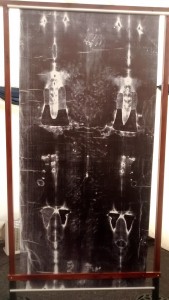‘God is great!’
That was one of the praises sung by thousands of Muslims at a convention in south east England last weekend. Nothing surprising there, you might say.
But there was one particular spot where many of them thought ‘Jesus Christ!’ – believing they were seeing the face and body of the Messiah himself.
Far from experiencing a vision, they were actually looking at a life-size replica of the world’s most cherished and also controversial relic: the Shroud of Turin.
The display was organised by ‘The Review of Religions’, one of the longest running journals about comparative religion, which had invited Barrie Schwortz, founder and editor of Shroud.com, and Pam Moon to share their work.
This may strike some as odd. Why would a Christian artefact have any appeal at a large Islamic gathering?
Jesus – or Isa, as he is called in the Qur’an – is among the great prophets of God, therefore anything related to his life (and death) would be of natural interest to Muslims.
The shroud is widely believed to have been the linen cloth that Jesus was wrapped and buried in following the crucifixion. It measures 14.5 feet by 3.5 feet, and bears the marks of a beaten man, with spear and nail wounds as well as blood stains from head to toe.
These all appear to be consistent with accounts in the Gospels (much of which Muslims also consider to be divinely inspired) about the torture of Jesus by Roman soldiers.
Hundreds of thousands of hours of research and experiments have been conducted on the shroud, described by Mr Schwortz as “the single most studied artefact in history”. He is a leading expert and probably best known authority in the field, so his voice matters.
His talk at the convention was a little over half an hour, but packed – much like the marquee in which he spoke. He traced the shroud’s origins and explained how modern means of testing have been used to verify its authenticity.
He also told of the cloth’s extraordinary survival, including in two fires, which is little wonder millions view it as a living miracle.
The fact that a Jew was speaking about a Christian relic to a mostly Muslim audience might sound like the making of a multi-faith joke, but this was serious stuff.
Mr Schwortz is well aware of criticism of his work and accusations that his life has been devoted to a medieval hoax, but he said he regarded the endeavour as “an obligation.”
Opinions about the shroud remain divided – including among Christians. The Catholic Church has always been cautious, and though the Vatican has never officially endorsed it, Pope Francis recently acknowledged it as an “icon of a man scourged and crucified.”
There are also disagreements within Islam.
Many orthodox Muslims believe that Jesus was never even put on the cross, but rather ascended to heaven whilst God replaced him with a lookalike who was killed instead. For them, the shroud holds little importance.
This differs from the position of Ahmadiyya Muslims who maintain that Jesus was indeed led to the mount of Golgotha and nailed, but as opposed to dying he became unconscious. He was buried but then later left the tomb and met his disciples before heading eastward.

There is an obvious pertinence here to the age old debate about the relationship between science and faith. The challenge for religious believers arises when empirical claims appear to conflict with particular doctrines, often leading them to reject the former. But thousands at the convention appeared to see no problem reconciling forensic evidence of the shroud with passages in holy texts. As was said by one of the delegates, “If religion is the word of God, science must be the act of God.”
The mystery of the shroud may never be fully solved, but if people of different faiths and worldviews can be brought closer in the pursuit of truth, as happened last weekend, that surely can’t be a bad thing.
This article by Waqar Ahmedi was published in ‘On Religion’ on Thursday 27th August 2015. Also available on Waqar Ahmadi’s wordpress blog –

Ask a question
You must log in to post your question. You can also Register here.